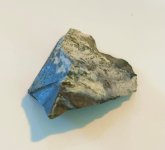TheRandyMan
Hero Member
- Apr 3, 2010
- 576
- 16
- Detector(s) used
- Excalibur II, Minelab Etrac, Ace 250k, Discovery TF-900
- Primary Interest:
- All Treasure Hunting
I have been researching the rapidly expanding field of water electrolysis to form hydrogen and oxygen which is then used as a catalyst to improve engine efficiency and thus fuel mileage and power. Typical gas engines operate in the 15% to 20% efficiency range with much of the energy lost in heat and unburned fuel out the tailpipe. Adding a hydrogen/oxygen mixture into the air intake increases engine efficiency by acting as a catalyst that helps burn 90% and more of the fuel...doesn't take a rocket scientist to figure out that is a good thing.
So, the question is...why aren't all the car manufacturers doing this??
Critics say its a losing proposition but the users swear its true.
Here is a typical exchange between critic and proponent...
Here is a fun riddle for you to work through on this Friday morning. I work for a high-tech RE/BACKUP engineering company. We have quite a few competent engineers around with formal training & vast experience in electronics. I’m not an engineer by training, but like tinkering for a good cause. I entered a discussion with one of our engineers - his expertise is in solar energy / backup, he also does quite a bit of car tuning. Needless to say he does engineering for living and knows his what he’s talking about. He is very skeptical after doing some research on the HHO technology. Maybe he’s missing some little nuance that can finally redeem the HHO technology in his eyes. Or we, HHO enthusiasts, are seriously misled?… Or I don’t have a firm grasp on the concept. What he says in short is that the battery energy drawn by a HHO cell to create the HHO gas is compensated by the engine using extra gasoline to crank the alternator to regenerate the energy and put it back into the battery. So the HHO cell puts extra load on the system. And whatever energy is released from HHO gas in the chamber is far insufficient to make up for the loss of the energy locked in the additional fuel the car uses with the HHO cell…
Response...
I have heard it all before- nothing new here… same old tired arguments about more energy being required to make hydrogen, than than energy out, blah, blah, blah…
1) First off- We are not making H2 (which is what their calculations are based on)- we are making HHO which is a completely unique form of electrified hydrogen with 34% oxygen content, and some very strange properties that are NOT similar to hydrogen in the form of H2 alone.
2) The engineers always use the same formula- but NEVER calculate the increased efficiencies of combustion by injecting a richer, faster burning catalyst PLUS 34% more oxidant/into the same 16 degree combustion cycle. The ICE (internal combustion engine) is currently only 15-20% efficient- it does not take much help to get an increase in efficiency. What they need to look at is the extracted energy that would be normally wasted as unburnt hydrocarbons, necessitating the catalytic converter to try and remove the toxins from the emissions. Most people report a sweet, ozone smell at the exhaust (including me).
I am probably going to buy one of these and try it out as in my mind, anything that can improve my 15% to 20% efficiency cant be bad.

So, the question is...why aren't all the car manufacturers doing this??
Critics say its a losing proposition but the users swear its true.
Here is a typical exchange between critic and proponent...
Here is a fun riddle for you to work through on this Friday morning. I work for a high-tech RE/BACKUP engineering company. We have quite a few competent engineers around with formal training & vast experience in electronics. I’m not an engineer by training, but like tinkering for a good cause. I entered a discussion with one of our engineers - his expertise is in solar energy / backup, he also does quite a bit of car tuning. Needless to say he does engineering for living and knows his what he’s talking about. He is very skeptical after doing some research on the HHO technology. Maybe he’s missing some little nuance that can finally redeem the HHO technology in his eyes. Or we, HHO enthusiasts, are seriously misled?… Or I don’t have a firm grasp on the concept. What he says in short is that the battery energy drawn by a HHO cell to create the HHO gas is compensated by the engine using extra gasoline to crank the alternator to regenerate the energy and put it back into the battery. So the HHO cell puts extra load on the system. And whatever energy is released from HHO gas in the chamber is far insufficient to make up for the loss of the energy locked in the additional fuel the car uses with the HHO cell…
Response...
I have heard it all before- nothing new here… same old tired arguments about more energy being required to make hydrogen, than than energy out, blah, blah, blah…
1) First off- We are not making H2 (which is what their calculations are based on)- we are making HHO which is a completely unique form of electrified hydrogen with 34% oxygen content, and some very strange properties that are NOT similar to hydrogen in the form of H2 alone.
2) The engineers always use the same formula- but NEVER calculate the increased efficiencies of combustion by injecting a richer, faster burning catalyst PLUS 34% more oxidant/into the same 16 degree combustion cycle. The ICE (internal combustion engine) is currently only 15-20% efficient- it does not take much help to get an increase in efficiency. What they need to look at is the extracted energy that would be normally wasted as unburnt hydrocarbons, necessitating the catalytic converter to try and remove the toxins from the emissions. Most people report a sweet, ozone smell at the exhaust (including me).
I am probably going to buy one of these and try it out as in my mind, anything that can improve my 15% to 20% efficiency cant be bad.








